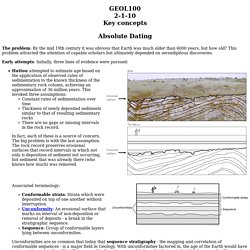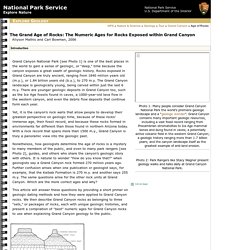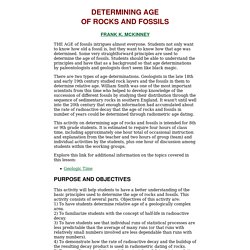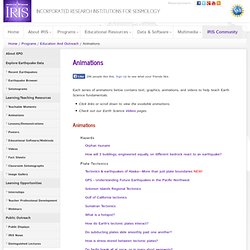

CSET - Geologic Time 083114 flashcards. Fairly Simple Exercises. John and Barbara Thomas The authors have been working with elementary school students for several years.

All of these exercises started 30 years ago when John was asked to do geology with the National Wildlife Association Conservation Summits. In his spare time, he always worked with several groups in the youth program (as young a four years old) and showed them rocks. One outgrowth of this was the exercise on classification. John was invited into his daughters' fourth grade classrooms to talk about geology and instead of talking about it designed and brought in activities. Introduction to Physical Geology Syllabus. The problem: By the mid 19th century it was obvious that Earth was much older than 6000 years, but how old?

This problem attracted the attention of capable scholars but ultimately depended on serendipitous discoveries. Early attempts: Initially, three lines of evidence were pursued: Hutton attempted to estimate age based on the application of observed rates of sedimentation to the known thickness of the sedimentary rock column, achieving an approximation of 36 million years. Formation of an Unconformity. Www.cposcience.com/home/portals/2/media/post_sale_content/pes/pes_chap_18/studentrecordsheets/pes_inv_as_18b.pdf. Age, Rocks, and Index Fossils.mp4. RELATIVE AGE. If the Law of Original Horizontality is applicable, it may be inferred that where sedimentary layers are found that depart appreciably from the horizontal, their inclination is the result of deformation that took place after the layers were deposited.

At location A, three layers are present. They have not been deformed and remain as originally deposited. The layers are covered except for the area within the circle. Looking at the exposed layers and applying the Law of Superposition, an observer concludes correctly that the bottommost layer (dark brown) is oldest and the topmost layer (orange-tan) is youngest. Nature & Science» Geology Resources Division. Since each of Grand Canyon’s three sets of rocks is unique, different dating techniques were used to determine the age of rocks in each set.

Radiometric dating techniques revealed the absolute age of the igneous and metamorphic rocks of the Vishnu Basement Rocks, and also provided dates on volcanic ash beds and other datable units in the mostly sedimentary Grand Canyon Supergroup. Relative dating, index fossils, and geologic correlation were used to determine the geologic age of the Layered Paleozoic Rocks, and numeric ages were then inferred. A wide variety of numeric ages for Grand Canyon rocks, particularly for the sedimentary rocks which usually cannot be absolutely dated, exist in both the technical and popular literature. When someone’s objective is really just to learn how long ago these rocks formed, it is very confusing to sort through subdivisions of geologic periods, the scientific names of microscopic index fossils, and the nuances of radiometric dating techniques. DETERMINING AGE OF ROCKS AND FOSSILS.
THE AGE of fossils intrigues almost everyone.

Students not only want to know how old a fossil is, but they want to know how that age was determined. Www.cposcience.com/home/Portals/2/Media/post_sale_content/FPS-ESS 2nd/Ancillaries/U10/U10_Skill_and_Practice_Sheets/FPSESS_U10_SS.pdf. Relative Dating #1: EARTH SCIENCE LAB. Www.fer.unizg.hr/_download/repository/Nuklearna_radioaktivni_raspad_raddecay9.swf. Why Do Rivers Curve? ASTR 1210, O'CONNELL. Study Guide 12 [Spring 2014] Visualization Collections. New Page 1. Earth Science Review Videos.
Seafloor Spreading. Plate Tectonics. ELI: Home. Layers. Downloads. Virtual Labs. The links on this page are all VIRTUAL LABS offered by the Glencoe textbook company.

These labs give the students the adventure of laboratory experimentation without costly supplies, worrisome environmental and safety issues, or time-consuming clean up. They are from all different areas of science: Biology, Physics, Genetics, Earth Science, Physical Science, and Chemistry. Please feel free to try these at home! Students will be directed to specific labs in class but there are over 100 labs offered here!
To return to the home page, please click here: Virtual Labs 1) What strategies are involved in solving a science problem? 2) How does thermal energy affect the state of a substance? 3) How can minerals be defined by their properties? 4) How are rocks classified? 5) What are the advantages of alternative energy sources? 6) How can locations in the United States be identified by their geographic features? Geology Labs - OnlineLabs.in - Virtual laboratory simulations for science education.
Earth's Magnetic Field. Convection and Heat. Geologic Time. Educational Videos. 60 questions total. Earth and Environmental Science Summative Assessment 54 questions Objectives Tested: 1.02, 1.06, 2.05, 2.01, 6.01, 6.02, 2.03, 2.06, 2.02, 2.04, 3.01, 2.07, 4.02, 5.01, 5.03.

CE3 Cyber-Enabled Earth Exploration. Are you interested in using the CE3 curriculum?

Fill out the form below to receive the password for the Teacher's Guide and additional information about the curriculum. We will send updates to you as new versions of the curriculum become available. Thanks, -The CE3 Team Registration Form for CE3 Curriculum To access the curriculum, click on the links to the right. Bauskaposter. Earth Science Lesson Plans. The Rock Cycle . Introduction. Www.lpl.arizona.edu/~isa/ptys170a1/resources/lecture22_planet_geology.pdf. Mantle Convection, Plate Tectonics, Earthquakes & Volcanoes - Maggie's Science Connection. Virtual Labs. Earth Science, 11e. Earth Science, 11e. Animations. Each series of animations below contains text, graphics, animations, and videos to help teach Earth Science fundamentals.

Click links or scroll down to view the available animations. Check out our Earth Science Videos pages. Animations Hazards Orphan tsunami How will 3 buildings, engineered equally, on different bedrock react to an earthquake? Plate Tectonics Tectonics & earthquakes of Alaska—More than just plate boundaries NEW! GPS - Understanding Future Earthquakes in the Pacific Northwest Solomon Islands Regional Tectonics Gulf of California tectonics Sumatran Tectonics What is a hotspot? How do Earth's tectonic plates interact? Do subducting plates slide smoothly past one another? How is stress stored between tectonic plates? Do faults break all at once, or in many short segments? Www.shakeout.org/california/downloads/ShakeOut_ES4_FindingPlates.pdf. Www.st.nmfs.noaa.gov/Assets/Nemo/documents/lessons/Lesson_13/Lesson_13-Teacher's_Guide.pdf. Untitled Document. All materials contained in this page were developed by and are the property of Arjuna Multimedia, Copyright 2007 Plate Boundaries It is apparent that most of what we observe on the surface of the earth and at shallow depth is related in some way to plate tectonics.

The beaches along the eastern margin of North America are the result of the weathering, erosion, and breakdown of a huge mountain range (the Appalachian Mountains) over the last 300 million years. Www.geosociety.org/educate/LessonPlans/SeaFloorSpreading.pdf. What is true north compared to magnetic north. Google Earth Tours of Glacier Change. Mauri Pelto Nichols College Author Profile This activity has been selected for inclusion in the CLEAN collection. This activity has been extensively reviewed for inclusion in the Climate Literacy and Energy Awareness Network's collection of educational resources.
For information the process and the collection, see This page first made public: Nov 27, 2007. Blog.uny.ac.id/pramudiyanto/files/2011/10/AIMS_Quake_Quest.pdf. Science Line sqtest. Answer 3: There are many ideas about why the Earth has many different layers, and no one really knows for sure. Most scientists believe that the existence of layers is because of the materials that make up rocks and minerals. Under different pressures and temperatures, rocks and minerals change "state", in other words, they can melt or crystallize to form different rocks. For example, do you know about the gemstone called Garnet?
It's a shiny red rock that people polish and cut and use in rings and necklaces. Earth Science - Activities/Labs. The Phenomenon Of Sound: Waves. Teaching Sound with Boomwhackers. Earth to Class. Earth Learning Idea - Innovative, Earth-related teaching ideas. Science Teaching Resources. Devils Tower.